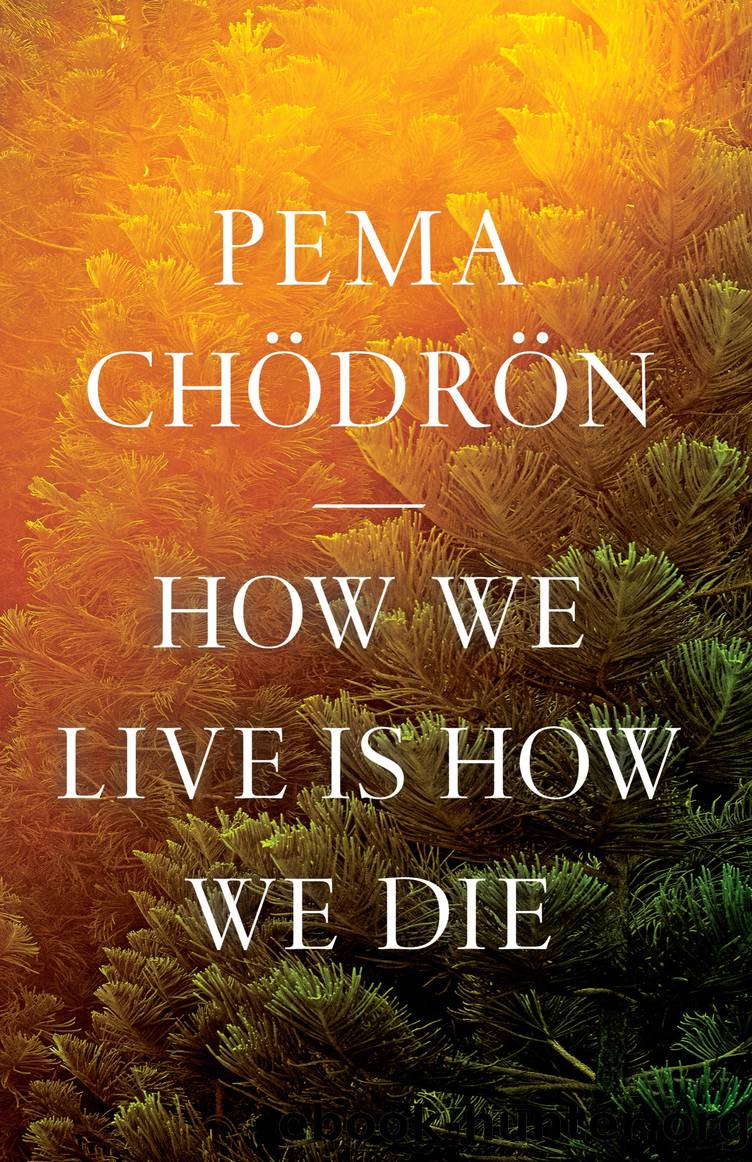How We Live Is How We Die by Pema Chödrön

Author:Pema Chödrön [Chödrön, Pema]
Language: eng
Format: epub
Publisher: Shambhala
Published: 2022-10-04T00:00:00+00:00
19
From Openness to Concreteness: An Eternal Pattern
According to the Buddha, all is never lost. This is because every living beingâfrom humans to tiny insects to invisible spiritsâhas the potential to wake up completely. How wondrous that all beings have that potential!
For anyone who hasnât prepared for death ahead of time, the opportunities for awakening during the bardo of dying and the bardo of dharmata will go by so quickly that they probably wonât be recognized. If an insect hits your windshield while youâre driving, it will have no awareness of luminosity or deities (unless itâs a very special insect) and will immediately find itself in the next bardo, the bardo of becoming. Here its propensities will draw it toward its next birth in one of the realms of samsara.
Our experience of the bardo of becoming is said to be exactly like our experience in a dream. When we dream, we donât go anywhere or do anything with our body. Our body lies asleep in our bed. But weâre still able to go through vivid, active experiences that feel real because our mind projects a mental body. This mental body can do all the things our physical body can do. But, because itâs less grounded than our waking body, it can do many other wonderful things as well.
In dreams, we can perform miracles: we can fly, we can go through walls, we can find ourselves in spaces and configurations that would be impossible with a solid, physical body. The situation in the bardo of becoming is just like this. Because the mental body is no longer tethered to anything physical, it can do amazing things. But the experience of this bardo is said to be more unsettling than thrilling. Itâs like being blown about by tremendously powerful winds. After some time in such a vulnerable and agitated state, most beings feel compelled to find a new body.
The experiences of dying, going through the intermediate state, and taking a new birth are said to match closely the daily process of falling asleep, dreaming, and waking up the next day. When we fall asleepâmuch like at the time of deathâour five sense consciousnesses begin to withdraw, one by one: a nightly process of dissolution. At the end of this, we experience a brief gap, which is much like the dawning of the mother luminosity at death. Itâs a moment of completely open space, of infinite potential. The gap is too fleeting for most of us to notice, but advanced meditators who can maintain awareness while falling asleep can observe and rest in this luminosity.
From out of that open space, the first intimations of form arise. As in the bardo of dharmata, these are egoless projections of our own mind. These appearances are so subtle and fleeting that theyâre extremely easy to miss. From here, we enter the world of dreams, where what we encounter seems to have more substance. Our mental body continues to have sensory experiences. These experiences donât always make sense
Download
This site does not store any files on its server. We only index and link to content provided by other sites. Please contact the content providers to delete copyright contents if any and email us, we'll remove relevant links or contents immediately.
The Way of Zen by Alan W. Watts(5843)
Ego Is the Enemy by Ryan Holiday(4043)
The Art of Happiness by The Dalai Lama(3420)
The Book of Joy by Dalai Lama(3274)
Why Buddhism is True by Robert Wright(2862)
Shift into Freedom by Loch Kelly(2714)
Spark Joy by Marie Kondo(2703)
Happiness by Matthieu Ricard(2550)
A Monk's Guide to a Clean House and Mind by Shoukei Matsumoto(2423)
The Lost Art of Good Conversation by Sakyong Mipham(2143)
The Meaning of the Library by unknow(2090)
The Third Eye by T. Lobsang Rampa(1900)
The Unfettered Mind: Writings from a Zen Master to a Master Swordsman by Takuan Soho(1881)
Anthology by T J(1772)
Red Shambhala by Andrei Znamenski(1766)
The Diamond Cutter by Geshe Michael Roach(1685)
Thoughts Without A Thinker: Psychotherapy from a Buddhist Perspective by Epstein Mark(1608)
Advice Not Given by Mark Epstein(1533)
Twilight of Idols and Anti-Christ by Friedrich Nietzsche(1511)
